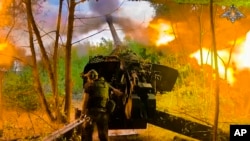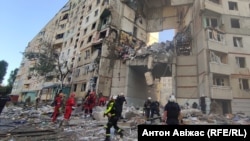Ukrainian President Volodymyr Zelenskiy is to deliver a speech at the United Nations General Assembly (UNGA) on September 25 ahead of presenting a “victory plan” to U.S. President Joe Biden amid relentless strikes on Ukraine’s cities and a grinding Russian offensive that is making slow but continuous advances into the eastern part of the country.
Zelenskiy has been on an intensive diplomatic mission since his arrival in the United States for the annual UNGA event, meeting with key U.S. lawmakers and appearing on U.S. media to urge Washington to maintain its crucial support for Ukraine.
Live Briefing: Russia’s Invasion Of Ukraine
RFE/RL’s Live Briefing gives you all of the latest developments on Russia’s full-scale invasion, Kyiv’s counteroffensive, Western military aid, global reaction, and the plight of civilians. For all of RFE/RL’s coverage of the war in Ukraine, click here.
The Ukrainian president told the UN Security Council on September 24 that Russia can only be “forced” into peace, and denounced Iran and North Korea as “accomplices” who have helped Moscow by providing weapons it has used in attacks on Ukraine.
Russian President Vladimir Putin has “broken so many international norms and rules that he won’t stop on his own. Russia can only be forced into peace, and that is exactly what’s needed: forcing Russia into peace as the sole aggressor in this war, the sole violator of the UN Charter,” Zelenskiy said.
Zelenskiy said the idea of talking with Putin would be “insanity” as he also criticized Russia for making Iran and North Korea “de facto accomplices in its criminal war in Europe, with their weapons killing us, killing Ukrainians.”
Kremlin spokesman Dmitry Peskov said on September 25 that Zelenskiy’s stance was “a fatal mistake” that would have grave repercussions for Ukraine.
“A position based on an attempt to force Russia into peace is an absolutely fatal mistake, because it is impossible to force Russia into peace,” Peskov said in a call with reporters.
“This is a profound misconception that will inevitably have consequences for the Kyiv regime.”
Details about Zelenskiy’s victory plan, which he is to discuss with Biden on September 26, remain unknown, but he said the blueprint will be a “bridge” toward ending the conflict.
Media reports say the plan will ask for stepped-up U.S. military and financial backing and security guarantees, as well as further sanctions on Russia.
The United States, Ukraine’s main supporter, and Western allies have given Kyiv billions of dollars in military aid and other assistance while also slapping several rounds of sanctions on Moscow.
Zelenskiy’s chief of staff, Andriy Yermak, has said the main security guarantee that Kyiv wants is NATO membership, a demand Kyiv has been advancing for years but which has been met with skepticism by the West, including Washington.
Zelenskiy has also indicated he will again seek permission to use long-range missiles to strike military targets deep inside Russia, a move Ukraine’s allies are divided upon.
On September 24, he called on Washington to take “decisive” action to bring the end of the war closer. In a meeting with a bipartisan delegation of U.S. lawmakers, Zelenskiy voiced Kyiv’s gratitude for what he called Washington’s unwavering support for Kyiv and highlighting the critical U.S. role in defending Ukraine’s freedom.
“Decisive action now could hasten the just end of Russian aggression against Ukraine next year. Our victory plan will help bring Russia to peace in practice,” Zelenskiy said on Telegram after the meeting.
“Now, at the end of the year, we have a real opportunity to strengthen cooperation between Ukraine and the United States,” he said.
Even without the details of Zelenskiy’s plan, some of Ukraine’s most stalwart Western allies have pointed to the need to find a compromise solution to the conflict.
Czech President Petr Pavel, whose country has been one of Kyiv’s strongest backers and the driving force behind a multibillion-dollar program known as the Czech Ammunition Initiative that has provided Ukraine with hundreds of thousands of artillery shells, told The New York Times in an interview published on September 23 that Ukrainians “will have to be realistic” about their chances of recovering all territories occupied by Russia.
“To talk about a defeat of Ukraine or defeat of Russia, it will simply not happen,” the newspaper quoted Pavel as saying. “So the end will be somewhere in between.”
Pavel added that Ukrainians also need to be “realistic about the support that they can achieve” from allies who are increasingly under domestic pressure to scale back help against Russia after more than 2 1/2 years of war.
Kyiv, which has around a fifth of its territory occupied by Russia, has repeatedly opposed such a possibility.
“There can be no half-hearted solutions when it comes to human lives, freedom, common values, justice for Russian crimes, restoration of international peace, and security,” the Foreign Ministry said in a post on Telegram after Pavel’s interview was published.
“Temporary solutions will not restore full-fledged peace but will only postpone war.”
Zelenskiy’s diplomatic offensive came as Russia stepped up its strikes on Ukraine. On September 25, Ukrainian air defenses shot down 28 drones and four missiles launched by Russia at 10 regions, Ukraine’s air force said in a statement on Telegram.
Russian drones and missiles were downed over the regions of Dnipropetrovsk, Kharkiv, Kyiv, Cherkasy, Kirovohrad, Sumy, Poltava, Mykolayiv, Odesa, and Kherson. Four more drones were “locally lost” in several regions of Ukraine, the statement said.
The latest attacks came a day after three people were killed and 24 wounded by a Russian strike on Kharkiv, Ukraine’s second-largest city.
In eastern Ukraine, Russian troops have stepped up their attacks on the Donetsk stronghold of Vuhledar as they seek access to the logistics hub of Pokrovsk, some 80 kilometers to the north.
Denis Pushilin, the Russian-installed head of Ukraine’s Donetsk region, said on September 25 that fighting was ongoing in Vuhledar, although the Ukrainian military said the city was not yet surrounded by Russian forces.
Moscow’s advances in the east appear to be the fastest over the past two years, despite a shock Ukrainian counteroffensive into Russia’s Kursk region last month.
This post was originally published on this site be sure to check out more of their content.










